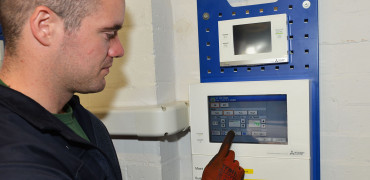I’ve had conversations with customers asking for the best, single controls strategy to adopt for an open plan office but the challenge here is that no one building is the same as any other and the use of energy within even apparently identical buildings will differ depending on the occupants and usage.
So open plan offices can provide one of the most challenging of environments to get right, not only do you have different ages and sexes, you can also have occasions where the office is half empty or crammed to bursting, which places different demands on the HVAC equipment.
Temperature may not be the only thing you need to check as without effective ventilation, any room can quickly become stuffy and stale.
“The best thing you can do is monitor the usage and that will help highlight any trends and areas you can look at”
The best thing you can do to control energy use and comfort in an open plan office space is to install a centralised HVAC controller.
Basic things to focus on
There are however, basic rules that you can follow to ensure you are maximising occupant comfort whilst minimising energy use.
The first thing to look at is the actual physical controls. How many do you have in the space and are they competing against each other? How much local control do people have over these? Are you monitoring them? And do you have a centralised controller as well?
We’ve all seen situations where one person will turn the air conditioning to high to warm up the place and another will simply turn to down to freezing 5 minutes later.
Not only is this failing to supply comfort to either of these people, it is wasting energy and placing a strain on the HVAC equipment which doesn’t know whether it is coming or going.
The simplest thing to do here is to lock the localised controller so that people can’t change it, or (far better), lock the range that they can play with. If you allow people to alter the temperature a little, then psychologically, they will feel better as they have been able to change things.
Room layout
The next thing to look at is the actual layout of the desks and office equipment.
Do you have lots of heat-generating photocopiers and printers blowing hot air over your occupants? Can these be moved to a better position for the humans in the room?
Do you have desks right next to doors or windows that will affect the occupants? And can these desks be moved or screened?
If you have surveyed the team, is it possible to group those that prefer a ‘cold’ room into one area so that they aren’t too hot or annoying their freezing neighbours?
Do you need to look at the HVAC vents to check the air flow and get it directed away from blowing directly on people below?
There are also ceiling cassettes and wall-mounted systems that will automatically monitor the body heat of room occupants and will adjust temperature, speed and airflow to suit.
Centralised controller
The best thing you can do to control energy use and comfort in an open plan office space is to install a centralised HVAC controller. Most VRF systems or larger split air conditioning units will be able to connect to one central control system.
This can then allow you to track temperatures and hot spots within a room and monitor energy use and consumption throughout the day, week or month.
What this will then allow you to do, is track trends of energy use and see where there are areas of concern, and when you are using most energy.
You would be surprised how much difference this can make to both the running costs and comfort levels in a building. It will help the HVAC plant get the space up to a comfortable temperature as economically as possible before the workforce arrives.
Then it will help you see when the hotspots are in each day, so that you can counter these before they become an issue.
Final thoughts
You may well find that your system already has centralised control but that it needs adapting so that it is not competing with the localised room controllers but is actually making them work together in one system.
Your installation or maintenance company can also help you and with modern systems, they can also monitor remotely, so they should be able to help you plan and adapt the best strategy to suit your own individual open plan space.



